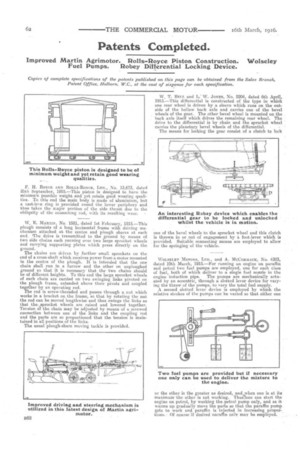Patents Completed.
Page 20

If you've noticed an error in this article please click here to report it so we can fix it.
Improved Martin Agrimotor. Rolls-Royce Piston Construction. %Iroiseley Fuel Pumps. Robey Differential Locking Device.
Copies of complete specifications of the patents published on this page can be obtained from the Sales Branch, Patent Office, Holborn, W.C., at the cost of sixpence for each specification.
F. H. floiccE AND ROLLS-ROYCE, LTD., No. 13,673, dated 25th liepternber, 1915.—This piston is designed to have the minimum possible weight and yet retain good wearing qualities. To this end the main body is made of aluminium, but a cast-iron ring is provided round the lower periphery and thus takes the major portion of the side thrust ; due to the obliquity of the connecting rod, with its resulting wear.
W. E. MARTIN, No. 1581,. dated ist February, 1915..—This plough consists of a long horizontal frame with driving mechanism attached at the centre and plough shares at each end, The drive is transmitted to the ground by means of two side chains each running over two large sprocket wheels and carrying supporting plates which press directly on the ground. The chains are driven by further small sprockets on the end of a cross-shaft which receives power from a motor mounted in the centre of the plough. It is intended that the one chain shall run in a furrow and the other On unploughed ground so that it is necessary that the two chains should be of different heights. To this end the large sprocket wheels of each chain are carried on two swinging links pivoted on the plough frame, extended above their pivots and coupled together by an operating red. The rod is screw-threaded and passes through a nut which works in a bracket on the frame, so that by rotating the nut the rod can be moved lengthwise and thus swings the links so that the, sprocket wheels are raised and lowered together. Tension ot the chain may be adjusted by means of a screwed connection between one of the links and the coupling rod and the parts are so proportioned that the tension is maintained in all positions of the links.
The usual plough-share moving tackle is provided.
W. T. BELL and L. W. JONES, No. 5204, dated 6th April, 1915--This differential is constructed of the type in which one rear wheel is driven by a sleeve which runs on the outside of the hollow hack axle and carries one of the bevel wheels of the gear. The other bevel wheel is mounted on the back axle itself which drives the remaining rear wheel. The drive to the differential is by chain and the sprocket wheel carries the planetary bevel wheels of the differential. • The means for locking the gear consist of a clutch to lock one of the bevel wheels to the sprocket wheel and this clutch is thrown in or out of engagement by .a foot-lever which is provided. Suitable connecting means are employed to allow for the springing of tho vehicle.
WOLSELEY MOTORS, LTD., and A. lillcCoRmacK, No. 4303, dated 19th March, 1915.—For running an engine on paraffin and petrol two fuel pumps are employed, One for each class of fuel, both of which deliver to a single fuel nozzle in the engine induction pipe. The pumps are mechanically actuated by an eccentric, through a slotted lever device for varying the throw of the pumps, to vary the total fuel supply.
A second slotted lever device is employed by which the relative strokes of the pumps can be varied so that either one
or the other is the greater as desired, ands hen one is at its maximum the other is not working. Thus7one can start the engine on petrol, by working the petrol pump only, and as it warms up gradually move the parts so that the paraffin pump gets to work and paraffin is injected in increasing proportions.. Of course if desired Paraffin only may be employed.




















